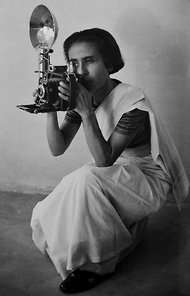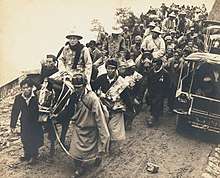Homai Vyarawalla
Homai Vyarawalla (9 December 1913 – 15 January 2012), commonly known by her pseudonym Dalda 13, was India's first woman photojournalist.[2][3] She began work in the late 1930s and retired in the early 1970s. In 2011, she was awarded Padma Vibhushan, the second highest civilian award of the Republic of India.[4][5] She was amongst the first women in India to join a mainstream publication when she joined The Illustrated Weekly of India.[6][7]
Homai Vyarawalla | |
|---|---|
 | |
| Born | 9 December 1913 Navsari, Bombay state, British India |
| Died | 15 January 2012 (aged 98) Vadodara, Gujarat, India |
| Nationality | Indian |
| Education | Sir J. J. School of Art |
| Occupation | Photojournalist |
| Spouse(s) | Manekcshaw Vyarawala (d. 1969) |
| Children | Farouq[1] |
Early life and education
Homai Vyarawalla was born on 9 December 1913[8] to a Parsi family in Navsari, Gujarat. Vyarawalla spent her childhood moving from place to place with her father's travelling theatre company.[9] After moving to Bombay, Homai Vyarawalla studied at Bombay University and the Sir J. J. School of Art.[10]
Personal life
Vyarawalla was married to Manekshaw Jamshetji Vyarawalla, an accountant and photographer for the Times of India.[11] In 1970, a year after her husband’s death, she gave up photography as she did not wish to work with the new generation paparazzi culture.[12] [13]
Homai Vyarawalla then moved to Pilani, Rajasthan, with her only son, Farouq who taught at BITS Pilani. She returned to Vadodara (formerly Baroda) with her son in 1982.[14] After her son's death from cancer in 1989, she lived alone in a small apartment in Baroda and spent her time gardening.[15]
Career
Vyarawalla started her career in the 1930s. At the onset of World War II, she started working on assignments for Mumbai-based The Illustrated Weekly of India magazine which published many of her most admired black-and-white images.[16] In the early years of her career, since Vyarawalla was unknown and a woman, her photographs were published under her husband's name.[17]
Eventually her photography received notice at the national level, particularly after moving to Delhi in 1942 to join the British Information Services. As a press photographer, she recorded many political and national leaders in the period leading up to independence, including Mohandas Gandhi, Jawaharlal Nehru, Muhammad Ali Jinnah, Indira Gandhi and the Nehru-Gandhi family.[17]

In 1956, she photographed for Life Magazine the 14th Dalai Lama when he entered Sikkim in India for the first time via the Nathu La.[18]
Most of her photographs were published under the pseudonym "Dalda 13″. The reasons behind her choice of this name were that her birth year was 1913, she met her husband at the age of 13 and her first car's number plate read "DLD 13″.[19]
In 1970, shortly after her husband's death, Homai Vyarawalla decided to give up photography, lamenting "bad behaviour" of the new generation of photographers.[20] She did not take a single photograph in the last 40-plus years of her life. When asked why she quit photography while at the peak of her profession, she said
"It was not worth it anymore. We had rules for photographers; we even followed a dress code. We treated each other with respect, like colleagues. But then, things changed for the worst. They were only interested in making a few quick bucks; I didn't want to be part of the crowd anymore."[16]
Later in life, Vyarawalla gave her collection of photographs to the Delhi-based Alkazi Foundation for the Arts and, in 2010, in collaboration with the National Gallery of Modern Art, Mumbai (NGMA), the foundation presented a retrospective of her work.[16] In 1998, she was honoured with the Chameli Devi Jain Award for Outstanding Women Mediaperson.[21]
Google honoured Vyarawalla on the 104th anniversary of her birth with a doodle, "First Lady of the Lens".[22]
Death
On January 2012, Vyarawalla fell from her bed and fractured a hip bone. Her neighbours helped her reach a hospital where she developed breathing complications. She had been suffering from interstitial lung disease which resulted in her death on 15 January 2012.[23]
References
- "India's first woman photojournalist, a chronicler of history". The Indian Express. 16 January 2012. Retrieved 9 December 2017.
- Pandya, Haresh (29 January 2012). "Homai Vyarawalla, Indian Photojournalist, Dies at 99". The New York Times. ISSN 0362-4331. Retrieved 16 September 2017.
- "Homai Vyarawalla: India's First Female Photojournalist | #IndianWomenInHistory". Feminism in India. 24 March 2017. Retrieved 17 September 2017.
- "An iconic observer – The curious life and times of Homai Vyarawalla". The Telegraph. 23 January 2011.
- "Homai gets Padma Vibhushan - Times of India". The Times of India. Retrieved 11 December 2017.
- Carolyn M. Byerly (12 January 2016). The Palgrave International Handbook of Women and Journalism. Palgrave Macmillan UK. pp. 391–. ISBN 978-1-137-27324-6. Retrieved 5 June 2018.
- "Google Doodle honours India's first woman photojournalist Homai Vyarawalla". The Economic Times. 9 December 2017. Retrieved 5 June 2018.
- "The Times of India on Mobile". M.timesofindia.com. 9 December 1913. Retrieved 16 January 2012.
- Pandya, Haresh (2012). "Homai Vyarawalla, Indian Photojournalist, Dies at 98". The New York Times. ISSN 0362-4331. Retrieved 16 September 2017.
- "Homai gets Padma Vibhushan". The Times of India. 25 January 2011.
- Pandya, Haresh (2012). "Homai Vyarawalla, Indian Photojournalist, Dies at 98". The New York Times. ISSN 0362-4331. Retrieved 16 September 2017.
- Cotter, Holland (23 August 2012). "'Candid,' Photos by Homai Vyarawalla, at Rubin Museum". The New York Times. ISSN 0362-4331. Retrieved 9 December 2017.
- Pandya, Haresh (2012). "Homai Vyarawalla, Indian Photojournalist, Dies at 98". The New York Times. ISSN 0362-4331. Retrieved 9 December 2017.
- "Homai Vyarawalla: First lady of the lens". Retrieved 16 September 2017.
- Sabeena., Gadihoke (2010). India in focus : camera chronicles of Homai Vyarawalla. Vyarawalla, Homai. New Delhi: Mapin Publishing in association with Parzor Foundation. ISBN 978-1935677079. OCLC 868304226.
- "Meet India's first lady photographer Homai Vyarawalla". Rediff.com. 3 March 2011.
- Gadihoke, Sabeena. "Homai Vyarawalla: India's First Female Photojournalist". Time. Retrieved 16 September 2017.
- Haresh Pandya, Homai Vyarawalla, Pioneering Indian Photojournalist, Dies at 98, NYT, January 28, 2012
- "Homai Vyarawalla: First lady of the lens". Retrieved 16 September 2017.
- Haresh Pandya, "Homai Vyarawalla, Pioneering Indian Photojournalist, Dies at 98", New York Times, 29 January 2012.
- Pillai, Meena T. (27 November 2014). "The way of the news, in her words". The Hindu. Retrieved 3 May 2019.
- Kalam, M (9 December 2017). "Homai Vyarawalla: Google Doodle celebrates India's first female photojournalist". TechObserver. Retrieved 8 December 2017.
- Vyarawalla, Homai. "India's first woman photojournalist dead". timesofindia.indiatimes.com. Retrieved 17 January 2012.
- Bibliography
- Gadihoke, Sabeena (2006), India in Focus: Camera Chronicles of Homai Vyarawalla, New Delhi/Ahmedabad: Parzor/Mapin Publishing, ISBN 978-81-89995-46-1
- Magazine articles
- Gaur, June (2004), "Lens view: Homai Vyarawalla", The Hindu (Online ed.), New Delhi (published 20 June 2004)
- Bunsha, Dionne; et al. (2005), "History, in black and white", Frontline (published 13 August 2005), 22 (18), archived from the original on 9 December 2007
- Sundaram, V. (2006), Homai Vyarawalla: India's First Woman Photo Journalist, New York: Boloji.com (published 3 March 2007), archived from the original on 13 December 2010, retrieved 12 November 2007